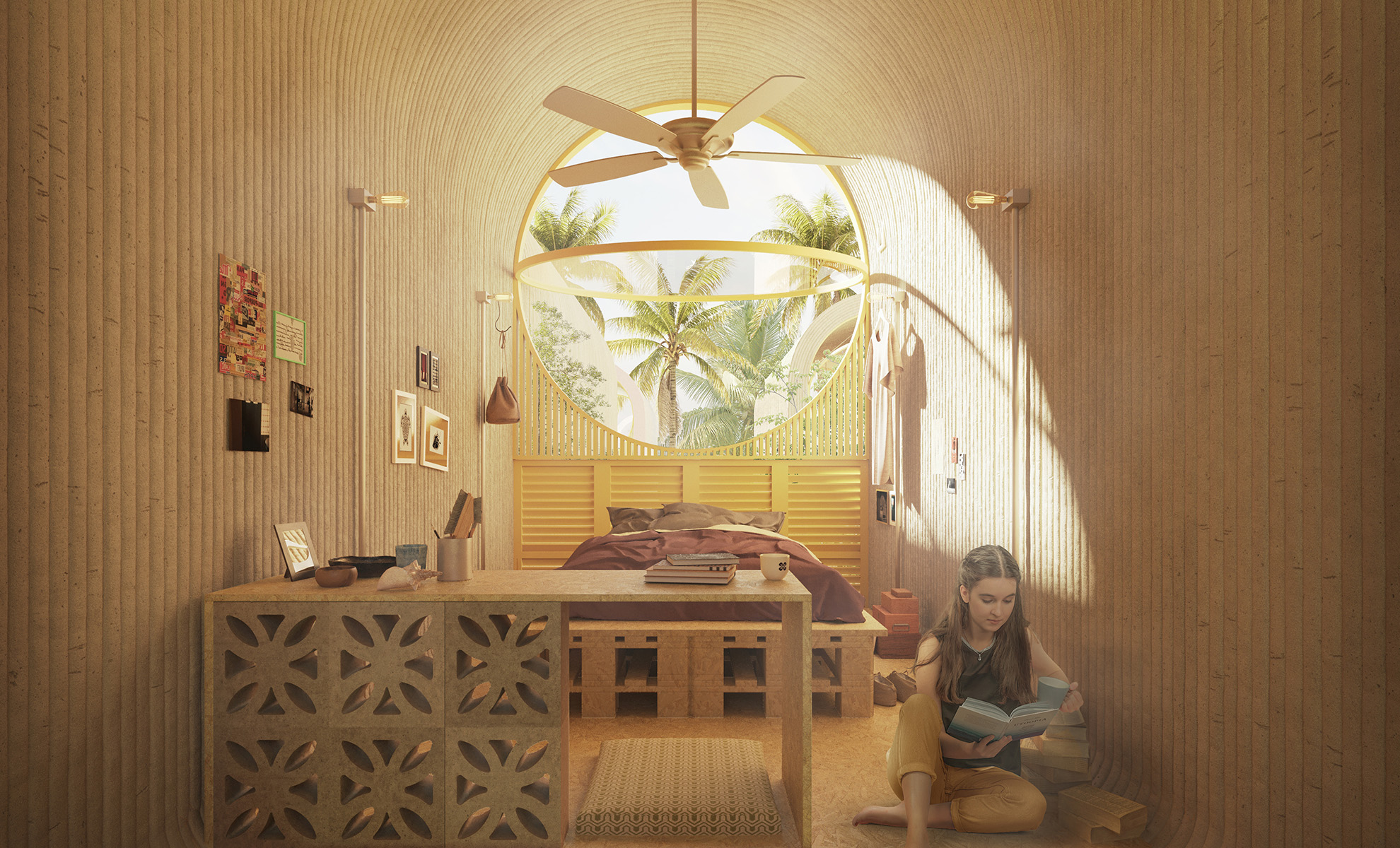
Wai Home by MTspace Studio
It was in 2018 that ICON unveiled its first 3D-printed (3DP) house in Austin, Texas: a small single-storey building, with a roof so wide it looks like a sombrero.
Very few 3DP homes had been built anywhere, much less in Texas and the idea was to bring them out of the realm of being talked about and provide a concrete example (pun intended) of what can be done: in this case, a prototype of a 600 sq ft building that took less than 24 hours to fabricate and was aimed at organisations working with economically vulnerable communities and/or in environments that made conventional building challenging.
Six years and 140 builds later, ICON’s ambitions have grown both geographically and commercially. It has built in Texas, Florida and both Mexicos old and New, and has plans to build in other states too. And it no longer provides just the equipment to print the buildings – an enormous rig which guides a giant icing nozzle piping concrete into perfect stipes – but has moved into developing properties itself. It’s House Zero design is a beautifully-curved pavilion-style home of 2,000 sq ft, and just about recognisable as a relation of the original prototype with its layered, grey walls and overhanging roof.
Now the company has invited architects and designers from all over the world to compete in its first Initiative 99, a competition to find the best in affordable house design (the “99” refers to the build budget, just $99,000 per unit) using 3D printing. The winning designs will be built on a piece of land in Austin earmarked as a “village” to accommodate those experiencing homelessness.
“We’ve had 260 entries from 60 countries,” says Melodie Yashar, ICON’s vice president of building design & performance. “The competition has conveyed the different narratives about need and affordability across the world.”
It’s not the first time that ICON has created this sort of mini-community: in Tabasco, a Mexican region close to the border with Guatemala, the company built 10 homes to accommodate families living in unsafe housing. But this time, as the results testify, the company is focused on aesthetics to a much greater degree. The renders of the designs are stunning: elegantly rippled walls that protect beautifully zoned interiors, a two-storey house that looks like a scaled-up version of a mantlepiece clock; another that could be a Thai temple sitting in a water garden.
Beyond Shelter is a beautifully wavy single-storey building, entered by Victoria Roznowski of Technical University Berlin, with planting tucked into the creases of its walls. Casa Fami is a modest family home designed by students from the Institute for Advanced Architecture of Catalonia, the walls of which have been configured into a honeycomb. Collective Parts is a far more conventional, modular style of build from Berlin-based practice, Beta Realities, while Housing Salinas is a tall, narrow building with an attractive curved roof line and circular first-floor window that drowns the double-height space in light, the work of London’s For Everyday Life. Juan Felipe Molano of the Universidad de los Andes has designed Printing Hope, a row of brightly-coloured terrace homes that already resemble an established neighbourhood and finally, Wai House, from New Zealand practice, MTspace_studio, an almost spectral pagoda, with a curving interior.
Are they really achievable at all, much less for $99,000?
“We’re very excited by the results,” says Yashar. “We put together a list of printer constraints and parameters for all the entrants. Some people have taken a bit of creative licence but they were all scored on printer and construction viability.”
“We’re very excited by the results,” says Yashar. “We put together a list of printer constraints and parameters for all the entrants. Some people have taken a bit of creative licence but they were all scored on printer and construction viability.”
So they can be built – in fact, ICON has a mesmerising video of some of its prints in progress, the familiar stripes of 3D printing replaced in one by a slight zigzag which makes the wall look as if it has been knitted rather than layered.
“The general public have not looked at the potential and new possibilities of 3D printing. We feel other providers aren’t making the most of it” Melodie Yashar, ICON
“We should be thinking about design much more,” says Yashar. “The material finish, how it can work with other materials” – the House Zero is a masterclass in exposing some of the printed concrete and cladding it in other areas to soften the overall look. “The general public have not looked at the potential and new possibilities of 3D printing. We feel other providers aren’t making the most of it.”
It’s true that, in Europe especially, 3DP housing has yet to take off and the examples that there are tend to be quite squat and unadventurous. The waves and curves that are second nature in this form of construction – but so hard to get right in conventional building – as well as the opportunity to create thermally-efficient homes whose layered (or knitted or latticed) structure is part of the aesthetic appeal should be inspiring us. Hopefully Initiative 99 will not only provide homes for those in need but will unleash the potential in this pioneering technology which has come so far in such a very short time.

















